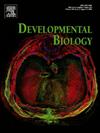Bud, branch, breathe! Building a mammalian lung over space and time
IF 2.5
3区 生物学
Q2 DEVELOPMENTAL BIOLOGY
引用次数: 0
Abstract
Many mammalian organs, such as the mammary and lachrymal glands, kidney and lungs develop by the process known as branching morphogenesis. An essential feature of this process is the reciprocal interaction between the inner branched tubular epithelium and the surrounding mesenchyme to optimize the final amount of epithelial tissue that is generated for specific functions. To achieve this expansion the initial epithelial population undergoes repeated rounds of bud formation, branch outgrowth and tip bifurcations, with each repertoire requiring dynamic changes in cell behavior. The process of branching morphogenesis was first studied experimentally by Grobstein and others who showed that the embryonic epithelium did not develop without so-called inductive signals from the mesenchyme. However, it was not known whether this activity was uniformly distributed throughout the mesoderm or localized to specific regions. The mouse lung was seen as a powerful system in which to investigate such questions since its early branching is highly stereotypic, both in vivo and in culture. This advantage was exploited by two young scientists, Alescio and Cassini, who used grafting techniques with explanted embryonic mouse lungs. They showed that mesenchyme from around distal buds could induce ectopic buds in the trachea and other non-branching regions of the epithelium. At the same time, distal regions denuded of their mesoderm failed to develop further. They speculated that inductive factors that promote bud formation and continued outgrowth in competent endoderm are specifically localized within the distal mesenchyme, establishing a conceptual framework for future experimentation. Since then, advances in many areas of biology and bioengineering have enabled the identification of gene regulatory networks, signaling pathways and biomechanical properties that mediate lung branching morphogenesis. However, a quantitative model of how these parameters are coordinated over space and time to control the pattern and scale of branching and the overall size of the lung, still remains elusive.

巴德,布兰奇,呼吸!在空间和时间上构建哺乳动物的肺。
许多哺乳动物的器官,如乳腺和泪腺、肾脏和肺,都是通过分支形态发生的过程发育的。这一过程的一个基本特征是内部支管上皮和周围间质之间的相互作用,以优化为特定功能产生的上皮组织的最终数量。为了实现这种扩展,初始上皮细胞群体经历了反复的芽形成、分支生长和尖端分叉,每一次都需要细胞行为的动态变化。分枝形态发生的过程最早是由Grobstein等人通过实验研究的,他们发现,如果没有来自间质的所谓诱导信号,胚胎上皮就不会发育。然而,尚不清楚这种活性是均匀分布于整个中胚层还是局限于特定区域。小鼠肺被视为研究这些问题的一个强大系统,因为它的早期分支在体内和培养中都是高度刻板的。两位年轻的科学家阿莱西奥和卡西尼利用了这一优势,他们用移植技术移植了小鼠胚胎肺。他们发现,来自远端芽周围的间质可以诱导气管和其他非分枝上皮区域的异位芽。同时,被剥去中胚层的远端区域无法进一步发育。他们推测,促进能态内胚层芽形成和持续生长的诱导因子特异性地定位于远端间质,为未来的实验建立了一个概念框架。从那时起,生物学和生物工程的许多领域的进展已经能够识别介导肺分支形态发生的基因调控网络、信号通路和生物力学特性。然而,这些参数如何在空间和时间上协调以控制分支的模式和规模以及肺的总体大小的定量模型仍然难以捉摸。
本文章由计算机程序翻译,如有差异,请以英文原文为准。
求助全文
约1分钟内获得全文
求助全文
来源期刊

Developmental biology
生物-发育生物学
CiteScore
5.30
自引率
3.70%
发文量
182
审稿时长
1.5 months
期刊介绍:
Developmental Biology (DB) publishes original research on mechanisms of development, differentiation, and growth in animals and plants at the molecular, cellular, genetic and evolutionary levels. Areas of particular emphasis include transcriptional control mechanisms, embryonic patterning, cell-cell interactions, growth factors and signal transduction, and regulatory hierarchies in developing plants and animals.
 求助内容:
求助内容: 应助结果提醒方式:
应助结果提醒方式:


